Issue Archive
Table of Contents
BLOOD COMMENTARIES
REVIEW ARTICLE
Doubling down: the new deal in the clinical management of double-refractory chronic lymphocytic leukemia
Care for patients with chronic lymphocytic leukemia has been revolutionized in the last decade as Bruton tyrosine kinase inhibitors and the B-cell lymphoma 2 inhibitor venetoclax have individually and in combination transformed outcomes. Where does that leave the small minority of patients who become refractory to both drug classes? That conundrum is tackled in this review by Grainger and colleagues as they discuss risk factors for development and mechanisms of resistance and highlight emerging treatment options including small molecule, bispecific antibody and chimeric antigen receptor T-cell therapies.
CLINICAL TRIALS AND OBSERVATIONS
Efficacy of combined CD38 and PD-1 inhibition with isatuximab and cemiplimab for relapsed/refractory NK/T-cell lymphoma
Clinical Trials & Observations
Extranodal natural killer/T-cell lymphoma (ENKTL) is an Epstein Barr virus–linked lymphoma, which has a poor prognosis after failure of frontline chemotherapy. In a phase 2 trial of cemiplimab, an anti–programmed cell death protein 1 (PD-1) antibody, in combination with isatuximab, an anti-CD38 antibody, in 37 patients with relapsed or refractory ENKTL, Kim and colleagues demonstrated a 51% complete response rate with a median duration of response exceeding 2 years. Accompanying correlative biomarker research suggests that programmed death ligand 1 expression, but not CD38 expression, on lymphoma cells may influence responsiveness to this therapy.
IMMUNOBIOLOGY AND IMMUNOTHERAPY
Standard-of-care idecabtagene vicleucel for relapsed/refractory multiple myeloma
Clinical Trials & Observations
Sidana et al report on the largest real-world analysis of chimeric antigen receptor T-cell therapy in multiple myeloma (MM), studying 821 patients, the majority of whom would have been ineligible for the pivotal trial, who received idecabtagene vicleucel (ide-cel), which targets B-cell maturation antigen (BCMA), in the late relapse setting. The 77% overall response rate, 25% complete response rate, and median progression-free survival of <9 months are consistent with the trial, expanding applicability and indicating that high-risk genetics, high disease burden, and prior anti-BCMA therapy are negative prognostic factors in multivariable analyses. As treatment options for patients with MM expand, these real-world data offer robust estimates of ide-cel efficacy and safety to guide clinical decision-making.
LYMPHOID NEOPLASIA
Genetic and epigenetic mechanisms of GPRC5D loss after anti-GPRC5D CAR T-cell therapy in multiple myeloma
Antigen escape is the predominant cause of failure for many chimeric antigen receptor T-cell (CAR-T) therapies, yet the mechanisms remain poorly understood. Ma and colleagues report on a detailed genomic and epigenomic study of the loss of G protein–coupled receptor, class C, group 5, member D (GPRC5D) expression post–anti-GPRC5D CAR-T therapy in multiple myeloma, unravelling a potentially reversible silencing mechanism driven by hypermethylation of its regulatory genomic loci. The authors’ findings stimulate many additional questions for the field and may suggest approaches to circumvent antigen escape.
Blunted CD40-responsive enhancer activation in CREBBP-mutant lymphomas can be restored by enforced CD4 T-cell engagement
Mutations in chromatin-modifying genes are key drivers of epigenetic deregulation in germinal center–derived B-cell lymphomas, with mutations in 1 such gene, CREBBP, occurring in approximately half. To understand how heterozygous loss-of-function mutated CREBBP alleles promote lymphomagenesis and aggressive transformation, Yang et al modeled lysine-acetylase domain mutations, finding dominant-negative effects and failure to activate key CD40-responsive genes, including major histocompatibility class 2 antigen expression. Furthermore, the authors reveal that CD20/CD3 bispecific antibodies can restore CD40-dependent upregulation of targets for immune cell killing, helping understand both why CREBBP mutations are important and how they may be informative for therapy.
MYELOID NEOPLASIA
BRAFV600E-positive mononuclear cells in blood at diagnosis portend treatment failure and neurodegeneration in pediatric LCH
Driven by mutations in BRAF or mitogen-activated protein kinase pathway genes, Langerhans cell histiocytosis (LCH) is a rare, incurable malignancy characterized by abnormal proliferation and accumulation of Langerhans cells, a type of dendritic cell, in various organs. Lin and colleagues analyzed a large retrospective pediatric cohort, finding that the presence of BRAFV600E in pretreatment peripheral blood mononuclear cells (PBMCs) predicts frontline treatment failure and LCH-associated neurodegeneration. The authors propose a new prognostic score for pediatric LCH that incorporates PBMC BRAFV600E status to more precisely identify high-risk patients.
RED CELLS, IRON, AND ERYTHROPOIESIS
THROMBOSIS AND HEMOSTASIS
Rapid ADAMTS13 activity assays for thrombotic thrombocytopenic purpura: a systematic review and meta-analysis
Clinical Trials & Observations
Severe deficiency or absence of ADAMTS13 is a critical diagnostic feature of thrombotic thrombocytopenic purpura (TTP), and newly available rapid assays can return results in less than 1 hour, potentially expediting diagnosis. Deshpande et al critically evaluated published data on the performance characteristics of rapid assays data on these new tests, identifying at least 1 with sufficient sensitivity and negative predictive value to incorporate into routine diagnostic algorithms. By reducing the time to diagnosis by days, many patients with thrombotic microangiopathy due to causes other than TTP can be spared invasive and expensive empiric therapy.
TRANSFUSION MEDICINE
The neutrophil antigen 3a/b polymorphism in SLC44A2 unexpectedly encodes the Csa/Csb red cell antigens
Brief Report
LETTER TO BLOOD
ANKRD26-related thrombocytopenia 2 with a baseline increase in blasts: implications for clinical surveillance
BLOOD WORK
-
Cover Image
Cover Image
![issue cover]()
A Wright-Giemsa–stained bone marrow aspirate smear from a patient with
ANKRD26 -related thrombocytopenia demonstrates small megakaryocytes with nuclear hypolobation, dysmorphic features that are seen at baseline in this disorder. See the article by Wahlster et al on page 254. - PDF Icon Front MatterFront Matter
- PDF Icon Table of ContentsTable of Contents
- PDF Icon Editorial BoardEditorial Board
Advertisement intended for health care professionals
Email alerts
Advertisement intended for health care professionals



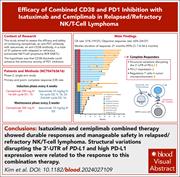

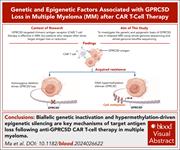


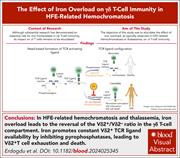
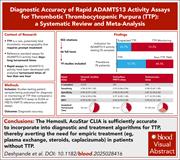
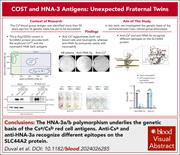


Reshaping the TME to enhance checkpoint blockade in ENKTL
Clinical Trials & Observations